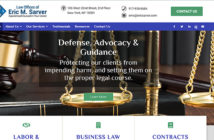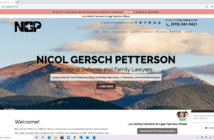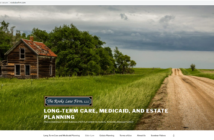Exact phrase pay-per-click ads drive traffic to a website featuring a 50-page book. Infusionsoft tracks downloads and follow-up. Conversion tracking is rougher, but the system is working.
Jim Hart is a divorce attorney in Cary, North Carolina. Previously, his law practice was based in Florida. He owns several websites. Jameshartlaw.com redirects to http://raleigh-divorce-lawyers.com/.
He also owns http://www.divorceguide.com/ and http://www.ncdivorceguide.com/.

His permission-based marketing strategy is simple. He created a North Carolina Divorce Guide, which is a 50-page ebook download that he offers for free on each of his websites. He then drives traffic to his websites using organic search and Google pay-per-click ads. He was specific in stating that he only uses Google AdWords and not Bing or Yahoo! paid advertising. That isn’t to say that he wouldn’t achieve results with them. He just doesn’t use them, for his own reasons.
He also incorporates analytics and conversion tracking so that he can measure what works and what doesn’t. Furthermore, he mentions other useful tools that might be of interest to attorneys interested in replicating his strategy.
Permission-based marketing is all about one thing — providing free value to site visitors in exchange for their e-mail addresses, which can then be used to send additional valuable information to them for the purpose of driving traffic back to your website and enticing recipients to call you for a consultation or to hire you to be their lawyer. It’s all based on providing valuable information to your prospect up front. Once you are perceived as an authority, based on the value of your information, then your prospect will be ready to do business with you.
1. What kind of marketing works best for you in generating new leads for your practice?
My law firm’s website is my best marketing asset. I use permission-based marketing and provide a lot of free information to clients and potential clients on my website, probably much more than the average attorney in my market.

I have a free divorce guide that is about 50 or 60 pages. It’s an A to Z guide to what you need to know about divorce in North Carolina. I use Google pay-per-click to drive traffic to that website and that free download. I’m very targeted in how I do that. I get a lot of people who will call and set an appointment with me after downloading that report.
2. Can you trace your leads directly to your free download or do your clients come to you through a variety of means including that free report?
I use a program called Infusionsoft. It’s sales and marketing software. It’s like Aweber on crack and costs $200 a month. It provides incredible value for my law practice.
I can tell you how many people visited my website and downloaded my divorce guide for a certain time period. I use an opt-in form on my website and also on other websites that own, which I drive traffic to using Google AdWords.
3. What kind of metrics are you using to measure your free download results?
I use Google Analytics to see how many people come to my website organically, but I use Infusionsoft to track my downloads and conversions. Since January 1 [and through the end of February], I’ve had 109 paid submissions and 41 through organic search. That’s roughly a two-third to one-third ratio.
I also track conversions, but I’m not as good at it as I should be. My assistant tracks the number of calls I get. I could aggregate it all – for instance, of 150 leads, 20 people scheduled appointments, 10 of those came in to the office, and 5 of those used my services – but I have not done that yet for 2014. My goal is to get to that point.
4. What specific tactics or strategies seem to be working best for you in terms of driving traffic to your free download?
I only use Google pay-per-click and organic search. It’s the sole way I drive traffic to that guide. Because I do have so much free content on my website, and I presume it’s valuable, I have a good level of traffic going to the site.
5. How many keywords do you include in your ad groupings, or do you target for specific keywords across the board?
I try to use quotes whenever possible because I want to capture people searching for exact phrases. Otherwise, you can spend a lot of money for generic terms, and there are other issues too. I have more than 100 keywords, but only 20-25 of them ever get any traffic. It’s the 80/20 rule.

6. I presume you run separate ad groups for each of your websites and landing pages even though they’re all peddling the same download. Is that correct?
I would, but I only have one web page that I drive traffic to. http://www.ncdivorceguide.com/ — that’s the only website I drive traffic to.
Google has very specific rules about the domain you’re using. At one point I tried testing two different websites, but Google said they had to have the same root domain, so I only have one campaign and it drives traffic to just one site.
7. Do you incorporate any social media marketing along with Google AdWords? If so, is that working out for you?
I have recently started doing social media. I’m trying to focus on Facebook. I’m trying to get more likes to my Facebook page.
I didn’t do a lot with Facebook until recently. I’m starting to do more, like putting quotes on my Facebook page and trying to create content that people really like to share and Like. I also incorporate paid traffic for my Facebook page, but I don’t spend a lot of money on that. It does provide social proof.
8. So are you using Facebook’s paid advertising for that?
Yeah, but it’s a small percentage of my advertising budget. It’s not a lot.
9. How would a lawyer go about getting started with permission-based marketing if they wanted to increase their exposure to potential new clients?
I would think about who your prospective client is. It’s going to be different for different people.
If your prospective client is other lawyers and you want to get more referrals from other lawyers, then you should think about that. If your prospective client is the end user, then come up with a list of top 10 questions for that person. Put together information in a Word document to answer all of those questions.
When someone gives you an e-mail address, they need to get something of value for that. A one page sheet with some basic information on it might not be valuable enough.
My divorce guide is a 50-60 page e-book. Your download needs to be information that your prospect can actually use. It needs to be information they can use when talking to an attorney, such as questions they might have about the legal process along with answers, or things they can put to practical use, like how to find the right divorce attorney. Build into that document information that is substantive and valuable. Build your platform around that.
You can use the information on your website, but I’d change the wording so that people aren’t getting duplicate information. People will give you their e-mail address for the benefit of getting that information as opposed to clicking through a lot of blog posts for it. Then they can read it at work or on their lunch break, whenever they aren’t around their spouse, or when it’s convenient for them.
The first thing is, pick your target client. Target your download toward that person. If you are trying to sell your services to people who have been injured on the job, then come up with something valuable that will appeal to that audience. If you want to attract insurance companies or other professionals who will send you referrals, then create a resource that will appeal to that audience.
10. About how long should it take before an attorney starts seeing new leads generated from their efforts in permission-based marketing?
I think it could happen immediately if you have a platform built around it. You want a website that has some substance to it. If you just have two pages that talk about who you are and what your business hours are, then people may not want to download your report. Put together the guide then you can start a pay-per-click ad campaign. You could start seeing results almost immediately.
My first law practice was in Florida. I started that in 2005. Then I moved to North Carolina in 2010. I built a website and then I started advertising with Google AdWords. I started getting leads in the first week.
11. What advice do you have about how to write a good landing page?
If you go to my website, http://www.ncdivorceguide.com/, you’ll see that I have one page about my free divorce guide. It talks about what you’ll get when you order the guide. I could do a lot more with it. I can do more to increase conversion rates by adding testimonials and other stuff, but I haven’t done that. There are other things I could do.

Dan Kennedy has a book titled The Ultimate Sales Letter where he tells you step by step how to write a landing page. He says the longer the better. Mine isn’t as long as it needs to be, but it’s working. It’s getting results.
12. What is your advice for building a website that converts?
Number 1, always have a web form prominently on your website so people can opt in if they want to. I have a plug-in for WordPress called Optin Skin. You can put an opt-in form anywhere on your website and put it right where you want it. I have my opt-in form on some pages but not every page.
You have to pay for it. It’s $67 for a single site license. You can remind people about your opt-in list so that if they have more questions, then they can order your free guide without having to go looking for your form.
Including pictures will cause people to convert more than not having a photo. The way you do that, there is a website called http://www.myecovermaker.com/. You can create an image and download it then put it into your ad or opt-in form to increase conversions.
Optin Skin is also customizable for Aweber, Infusionsoft, or whatever autoresponder or marketing software you are using.
A large website is better because the way Google works, long-tail keywords are easier to rank for. If you have 300 pages and each page gets one view, then that’s 300 page views. If you have 20 pages, that’s only 20 page views. You have more opportunities to get ranked for more pages in Google with a larger website. But you want to make sure that each page provides valuable information for your site visitors.
13. How far apart do you program your autoresponders, and what do you say in them? Are you offering divorce tips? What’s the “valuable” information you are providing in those periodic mail outs, and are they automatic?
Not long enough. They get four or five messages in the first fifteen days. After that, they are bumped into what I call the long-term campaign. If they haven’t called me or become a client by then, they’ll get a message every month or so.
I’ve found that people call right away. Most of the ones who become clients download the e-book and read it right away. After they’ve read through it, they’ll call the next day.
If I was doing it the right way, if was an attorney starting out with Google AdWords today and wanted to do it the right way, I’d program the autoresponders to go out more often. I’d send out the initial messages every two or three days then transition to once a week. I haven’t done that because I’m getting enough work. It’s not like I’m twiddling my thumbs looking for something to do.
14. Do you also blog?
Yes. I try to do one or two blog posts per week. I also plan to do some podcasting.
I do some podcasting now at http://www.legalmarketingmadeeasy.com/, which is targeted toward other lawyers.
Podcasting is more difficult because I devote more time to it than I do the blog posts. I try to write a thousand words a day. Right now I’m working on an e-book for http://www.legalmarketingmadeeasy.com/. That’s taking up most of my time, and that’s where I’m currently putting my thousand words a day. When I finish that I’ll probably start blogging again.
I could hire a ghostwriter to write my blog for me, but I haven’t done that. I’d rather do it myself. I like writing. Plus, people come in and ask me if I write my own content and I can legitimately tell them, “Yes.”
15. What other suggestions do you have for lawyers regarding attracting new clients or generating leads from permission-based marketing and free reports?
Be sure to include a call to action on your download page. It can be an e-course, an e-book, or anything of value that will drive people back to your website. Include social share buttons, or you can invite people to call you for a consultation. So long as your visitors are doing something. And remind them of the value that you’re providing.
You don’t want to spam anyone. Don’t send out unwanted e-mail. If you provide your subscribers with information that is obviously trying to sell them something, you’re spamming them. Follow up e-mails need to be high value, high quality information that will provide value for them. Practical tips that will help them. Don’t sell. The more you teach and educate, the more you’ll be perceived as an authority. I get people coming to me and telling me, “I’m hiring you because you provide so much information that is helpful.”
Takeaways
Start by defining your prospect. Then make a list of the most important questions that prospect has about your type of law practice. Write out answers to those questions in the form of an e-book. Pack that book full of valuable information and sell its benefits on a single landing page designed to get people to give you their e-mail addresses in exchange for the valuable information.
The most important thing to remember is Value.



